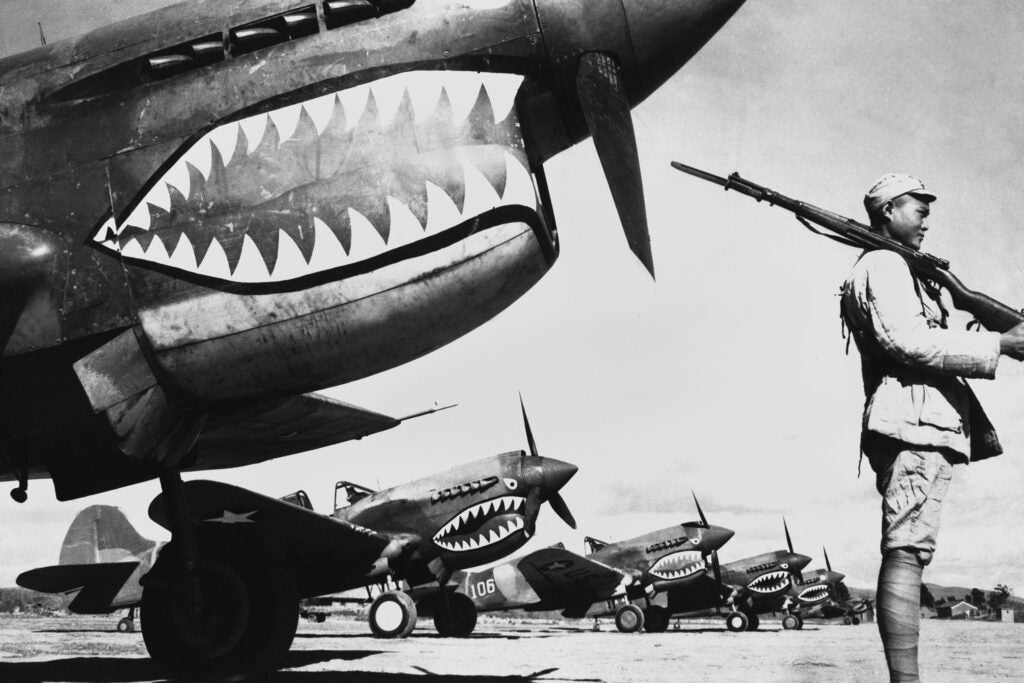The Spirit of the Flying Tigers: A Moment of Cooperation between the US and China
The China-US rivalry is one of the most critical and complex arenas in international politics. Joseph Nye, Professor at the Harvard Kennedy School, considers the relationship between the two superpowers to be fraught and highly competitive. However, both China and the US have recently restored high-level strategic communication through bilateral dialogue. Following US Secretary of State Antony Blinken’s visit to Beijing in June 2023 to discuss “maintaining open lines of communication” and “responsibly managing US-China relations” with China, Chinese President Xi Jinping returned the visit by attending the Asia-Pacific Economic Cooperation (APEC) San Francisco in November 2023. This mutual exchange has led political observers to note an improvement in the relationship between the two superpowers.

During these mutual visits, the American Volunteer Group (AVG), alias Flying Tigers, was mentioned as a shared memory of cooperation between the two countries. The US Embassy in Beijing hosted an official recognition ceremony for the Flying Tiger veterans, honouring the brave Americans who fought alongside the Chinese people during World War II (WWII) while Flying Tigers veterans were invited to a welcome banquet during President Xi Jinping’s visit to San Francisco, indicating Beijing’s interest in reviving this memory. A spirit of cooperation, as symbolised by the Flying Tigers, could be key to peacefully resolving regional and global conflicts.
The Flying Tigers
The Flying Tigers were born during the Sino-Japanese conflict. On 7 July 1937, the Japanese attacked China, occupying strategic positions and ports in the north. As a result, China’s north-eastern and south-eastern access to the external world was cut off. In order to deal with this blockade, a plan was proposed to build the Burma Road in August that year, which was endorsed by the Chinese leader, Chiang Kai-shek, at the time. The Burma Road, which passes through Myanmar, provided a route for the convoy of supply and manpower from outside of China. However, as soon as the road was opened in November 1938, the Japanese intensified their strikes on this “lifeline to the West”.

To secure the road, the US (which was still neutral in the conflict at the time) and China reached a secret agreement on 15 April 1941, which allowed US reserve troops and veterans from the Army Air Corps (USAA), Navy, and Marine Corps to fight on China’s behalf. Claire Lee Chennault, a retired USAA officer who served as aviation advisor to Chiang Kai-shek, then privately recruited volunteers as “employees” under the guise of the Central Aircraft Manufacturing Company (CAMC). The CAMC was a China-US joint venture military enterprise that was founded in Hangzhou on 8 December 1933, but had relocated to Ruili, Yunnan, in 1939 due to the war. On 10 July 1941, the first AVG pilots departed from San Francisco and assembled in Toungoo, Myanmar, for training. Having concluded training on 20 December 1941, the newly-trained AVG pilots flew their P40 fighters, painted with sharks, over Kunming for their first air combat with the Japanese. After an overwhelming victory, Yunnan’s newspapers began to hail the AVG as the “Flying Tigers”.

On 7 December 1941, the Japanese attacked Pearl Harbour, which led the US government to join the war and integrate the AVG into its regular armed forces. Following US entry, US President Roosevelt strengthened the American Air Force in China by establishing the 14th Army Air Force of the USA (the 14th AAF) in March 1943. Chennault was appointed Major General Commander and by the end of October 1943, the Chinese-American Composite Wing of the 14th American Air Force (CACW) was established. This unit was an important component of the 14th AAF and signified the joint effort of the US and China against a global threat and of “Sino-US friendship.” The Spirit of the Flying Tigers (SFT) thus harkens to a period of “cooperation”, “friendship”, and “international assistance”.
Approximately 18,000 American volunteers came to China and fought against the Japanese. Of this number, around 2193 Flying Tigers lost their lives during flying missions along the Hump. The Hump was an 800-kilometre route from Assam to Kunming which passed through the Himalayas and the extreme climate and brutal battles in the air led to the countless death of pilots and the destruction of fighter planes. The battles across the Hump proved the Flying Tigers’ spirit of heroism and sacrifice in the context of international assistance. In 1993, the Hump Monument was built in Kunming to commemorate their efforts.

The Value of the Flying Tigers Spirit in the China-US Relationship
The emphasis of the Flying Tigers by China and the US on significant diplomatic occasions is an attempt to frame the shared memory of “friendship” and “cooperation” to ease ongoing tensions. This was reiterated on 12 September 2023, when Chinese President Xi Jinping mentioned in his reply to a letter from several Americans (Jeffrey Greene, chairman of the Sino-American Aviation Heritage Foundation (SAAHF), and Flying Tigers veterans, Harry Moyer and Mel McMullen) that “the health and stable development of China-US relations in the new era requires the participation and support of ‘new generations of Flying Tigers’”. The Chinese media also commented that the SAAHF has greatly contributed to rekindling the “[Flying Tigers] spirit of cooperation between the two peoples and enhancing their friendship and understanding” as well as educating young people about the accomplishments of their forebears.
Washington also looks back on its past collaboration with China to seek inspiration for resolving diplomatic tensions. In October 2023, the US Ambassador to China, Nicholas Burns, hosted a ceremony honouring Flying Tigers veterans in the embassy highlighting the importance of revisiting this moment while Flying Tigers veterans, including Jeffrey Greene, stated how “the (Flying Tigers) spirit is a shared spiritual heritage of the American and Chinese people. Greene however indicated that although the story of the Flying Tigers is well known in China, “most Americans don’t know about the Flying Tigers.” Furthermore, Nell Calloway, granddaughter of Chennault and Director of the Chennault Aviation and Military Museum, mentioned in an interview how:
“The story of the Flying Tigers symbolises the enduring friendship between the people of China and the United States…We need to remember history and share more stories like those of the Flying Tigers to pass the friendship between the two peoples on.”
For Beijing, the SFT represents its aspiration to build a New Model of Major Power Relationship (NMMPR) to resolve China-US conflicts through cooperative partnership. In international politics, major powers’ conflicts are driven by leadership contestation, the increasing convergence of ‘hard power’, and strategic competition in norms and values. Especially in Southeast Asia, a place “where great powers meet”, the region appears to have been the arena for geopolitical rivalry. According to the Center on China-US Relations’ Report, Prioritizing Southeast Asia in American China Policy, the US wants to contain China’s Belt and Road Initiative (BRI) engagement with Southeast Asia’s developing countries, which might lead to conflict. Regional countries prefer however a stable major-power relationship. In this scenario, invoking the SFT of “cooperation and friendliness” satisfies Beijing’s desire to resolve regional conflicts between China and the US and fits its shared global governance model, the NMMPR.

Southeast Asia also faces many security challenges, such as the Myanmar crisis, climate change, and contestations in the South China Sea. Instead of competition, Distinguished Fellow at the Asia Research Institute Kishore Mahbubani has argued that China and the US should “join hands on complex political challenges, such as jointly pushing for a solution to the political turmoil in Myanmar. Such efforts could help build mutual trust and lay the foundation for further cooperation.” This echoes what US Congress members have stated, that “China and the United States had cooperated in the fight against fascism, and that experience could inspire the two countries to join forces and work together to combat global warming.” “The Flying Tigers showed us 80 years ago that protecting the world lies entirely in shared responsibility", it was added. "Only cooperation can help us solve our common challenges.”
The Flying Tigers story can also be a pathway towards a revitalisation and enhancement of public exchanges. One way this could be done is for both countries to integrate the SAAHF and Kunming Flying Tigers Memorial Hall as partners and emphasis them as a facet of China-US Social and Cultural Dialogue. With financial support and government promotion, these organisations would appeal to the broader public and can be expanded to cooperation in other aspects such as education, science and technology, environment, culture, health, and social development.
Finally, although Beijing did not explicitly mention the Flying Tigers’ “international assistance” in wartime, it can be inferred that the emphasis is not just on humanitarian assistance but also the respect for regional norms. For example, the ASEAN Outlook on Indo-Pacific (AOIP) promotes security cooperation in the Indo-Pacific region by the respect for open regionalism and other regional shared cooperative norms. The effective implementation of the STF in the international community thus requires not only the strengthening of the ‘cooperation between major powers’ in terms of practical “international assistance” but also in the upholding of security and cooperation.
Conclusion
The Flying Tigers story is a shared memory of China-US cooperation and the reintroduction of this history is a positive sign of a détente in bilateral relations. Promoting the SFT has the potential to improve bilateral cooperation and inspire further collaboration in global governance. Although the two countries attach different degrees of importance to it, there is a consensus that the restoration and enhancement of youth-oriented public socio-cultural diplomacy is a prerequisite. According to reports, China’s last Flying Tigers veteran died in 2010, and the few surviving American Flying Tigers veterans are all around 100 years old. The advanced age of the veterans means that it is even more important that this shared history continues to be remembered in both countries and passed down to future generations even during periods of tension between the US and China. While there is still some ambiguity in implementing the SFT, it is still an important emerging socio-cultural discourse that frames the China-US as one of cooperative relationship rather than competition. The SFT requires sustainable institutional arrangements to promote participation and achieve appeal in both countries. The SFT is thus a promising avenue where one can break new ground while maintaining a coherent and cooperative regional and global order (守正创新).
The views expressed in this forum are those of the individual authors and do not represent the views of the Asia Research Institute, National University of Singapore, or the institutions to which the authors are attached.
Duan Haosheng is from Kunming, Yunnan, China, where the American Volunteer Group (AVG) (Flying Tigers) regional base was located. He is a PhD candidate in International Development Studies at the Faculty of Political Science, Chulalongkorn University and was formerly an Asian Graduate Student Fellow at the Asian Research Institute, National University of Singapore, in 2023. His research interests are in International Development Studies, Southeast Asian Studies, International Relations, and Mekong Studies.
Contact: 6384313624@student.chula.ac.th, dhszero@163.com
Zeng Damei is a PhD candidate from the School of International Relations and Center for Southeast Asian Studies, Xiamen University. She was previously a visiting scholar at Pridi Banomyong International College, Thammasat University. Her research interests are in China's foreign policy and the international politics of Southeast Asia.
Contact: 25520190154418@stu.xmu.edu.cn
Liu Yunkang is a PhD student at the University of New South Wales. He received an MA in International Development Studies from the Faculty of Political Sciences, Chulalongkorn University, and an MBA in Asia-Pacific Business from NIDA Business School, the National Institute of Development Administration, Bangkok. His research interests are Development Studies in Contemporary Southeast Asia, Asia-Pacific Studies, International Business and Politics.
Contact: liuyunkang54@gmail.com











